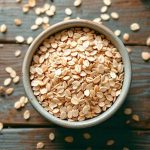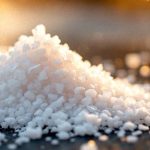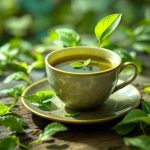Takeaways
- Oat straw offers potential stress-reducing properties
- It may support cognitive function and mental clarity
- Oat straw contains nutrients that could benefit heart health
- It’s a source of compounds that may contribute to bone strength
- Oat straw has traditional uses for supporting skin health
What is Oat Straw?
Oat straw is derived from the Avena sativa plant, more commonly known as oats.[1] It consists of the stem and leaves of the oat plant, harvested while it’s still young, before the grain develops fully.[2] This green, grassy material is distinct from the familiar oat grains used for making oatmeal.
Oats are cultivated by farmers across the world, and they tend to grow best in temperate climates.[3] These plants are tall and slender, often reaching heights between 2 and 5 feet.[4] Their leaves are long and flat, while the stems are hollow and have joints.
For health purposes, the above-ground parts of young oat plants are used.[5] These parts are harvested when the plant is still green and full of life, before it produces seeds. This ensures the highest concentration of beneficial compounds.
Historical Use of Oat Straw
Traditional Medicine
Oat straw has been used in traditional medicine for centuries across many cultures. European herbalists have historically used it to help with nervousness and support general health.[6] In the Middle Ages, it was thought to increase energy and stamina.[7]
Traditional healers used oat straw to relieve skin irritation and encourage restful sleep.[8] It was also suggested for digestive problems and to support women’s health. In some areas, people used it directly on the skin to soothe muscle and joint pain.
Modern Rediscovery
Recently, oat straw has become more popular in wellness practices. People focused on health are discovering its potential benefits. This increased interest has led to more scientific investigation into its properties.
Researchers are currently studying how oat straw affects stress, thinking, and heart health.[9] Although many traditional uses don’t have scientific proof, modern studies are exploring its possibilities. This combination of history and current research is increasing the popularity of oat straw in natural health products.
Nutritional Profile of Oat Straw
Oat straw contains various nutrients that may contribute to its potential health benefits. This section will examine the nutritional makeup of oat straw and how it compares to other common herbs.
Oat straw is rich in vitamins, minerals, and other beneficial substances.[10] It has a significant amount of silica, a mineral that is important for healthy bones and connective tissue.[11] Oat straw also contains calcium, magnesium, and potassium, which are important for different bodily functions.[12]
| Nutrient | Amount per 100g |
|---|---|
| Calcium | 1.3g |
| Magnesium | 0.33g |
| Silica | 0.6g |
| Potassium | 2.1g |
| Iron | 0.03g |
Besides these minerals, oat straw provides vitamins B1, B2, and B6.[13] These B vitamins are essential for energy production and a healthy nervous system. Oat straw also contains small amounts of vitamin E, an antioxidant that helps with skin health and the immune system.[14]
Compared to other herbs, oat straw is notable for its high silica content.[15] While some herbs like horsetail also have silica, oat straw offers a more balanced mix of nutrients. Its combination of minerals and B vitamins makes it a unique supplement among herbs.
Potential Health Benefits
Stress Reduction
Oat straw might help manage stress by affecting the nervous system.[16] It contains substances that could influence the activity of neurotransmitters in the brain. These natural chemicals may help promote feelings of calm and relaxation.
Traditionally, herbalists have recommended oat straw for exhaustion and anxiety. Modern research is now exploring these traditional uses. Some studies suggest that oat straw extract might reduce symptoms related to stress.[17] However, more research is needed to confirm these findings.
Cognitive Function
Oat straw shows potential for supporting brain health and mental performance. It may have an impact on several areas of mental function:
- Memory
- Focus and concentration
- Mental clarity
- Processing speed
Research into oat straw’s benefits for thinking is still underway. One study showed that older adults who took oat straw extract improved their cognitive performance.[18] The extract appeared to improve focus and attention. However, these findings are preliminary, and more research is necessary.
Some scientists believe that oat straw’s possible cognitive benefits might be due to its effect on blood flow.[19] Oat straw could increase blood flow to the brain, which might improve mental function. This idea fits with the traditional use of oat straw for promoting mental clarity.
Heart Health
Oat straw may provide benefits for heart health. Its nutrient content includes substances that support heart function.[23] For example, the magnesium in oat straw helps to regulate heart rhythm and blood pressure.[20]
Some studies suggest that oat straw might help lower cholesterol.[21] A study on rats found that oat straw extract reduced total cholesterol and LDL (bad) cholesterol.[22] While these results are encouraging, human studies are needed to verify this effect.
Oat straw also contains antioxidants that might protect against damage from oxidation. This protection could benefit heart health by reducing inflammation in blood vessels. However, more research is needed to fully understand how oat straw affects cardiovascular health.
Bone Strength
Oat straw’s possible role in supporting bone health comes from its mineral content. It provides calcium and silica, two minerals that are important for bone development and strength.[24] These nutrients may support bone density and reduce the risk of bone loss.
Silica, in particular, helps the body absorb and use calcium effectively.[25] This relationship between silica and calcium could make oat straw especially helpful for bone health. Some herbalists suggest oat straw as a natural supplement for people who are concerned about bone strength.
While the mineral content of oat straw is promising for bone health, there is limited clinical research available. More studies are needed to determine how well the body absorbs and uses these minerals from oat straw.
Skin Health
Oat straw’s potential benefits for skin health can come from both consuming it and using it topically. When consumed, its nutrients may support skin health from the inside. The silica in oat straw might help with skin elasticity and collagen production.[26]
Oat straw has been used directly on the skin to soothe irritations.[27] Its anti-inflammatory properties might help reduce redness and itching. Some skincare products include oat straw extract for its potential calming effects.
Traditional uses of oat straw for skin health involve bathing in water infused with oat straw. While there is some evidence based on personal experiences, scientific studies on oat straw’s skin benefits are limited. More research is needed to confirm its effectiveness for different skin conditions.
How to Use Oat Straw
Forms of Oat Straw
Oat straw is available in several forms, each providing different ways to incorporate it into your wellness routine:
- Tea
- Tincture
- Capsules
- Powder
- Topical preparations
Oat straw tea is a common and easy way to use this herb.[28] People often drink it for its calming effects and potential health benefits. Tinctures offer a concentrated form of oat straw, while capsules are a convenient choice for those who don’t like the taste of the tea.
Dosage and Preparation
The right amount of oat straw to use can vary depending on the form and what you are using it for. It’s always best to follow the instructions on the product or ask a healthcare provider for personalized guidance.
To make oat straw tea, a typical method is to steep 1-2 teaspoons of dried oat straw in hot water for 10-15 minutes.[29] Some people drink this tea up to three times a day. Tinctures usually require a smaller dose, often measured in drops.
| Form | Typical Dosage |
|---|---|
| Tea | 1-2 tsp, 3x daily |
| Tincture | 30-40 drops, 3x daily |
| Capsules | As directed on label |
When preparing oat straw at home, make sure you use high-quality, organic oat straw from a trusted source. Store dried oat straw in a cool, dry place to keep it fresh.
Potential Side Effects and Precautions
While oat straw is generally considered safe for most people, it’s important to be aware of possible side effects. Some people might experience mild stomach upset when they first use oat straw.[30] This usually gets better as the body adjusts.
Allergic reactions to oat straw are rare but possible.[31] People who have celiac disease or are sensitive to gluten should be careful, as oat straw might contain traces of gluten.[32] Always choose products that are certified gluten-free if this is a concern.
Certain groups should consult a healthcare provider before using oat straw:
- Pregnant or breastfeeding women
- People taking blood-thinning medications
- Individuals with hormone-sensitive conditions
- Those with known allergies to oats or related grains
As with any supplement, it’s best to start with a small amount and see how your body responds. If you experience any unusual symptoms, stop using it and consult a healthcare professional.
Oat Straw vs Other Supplements
Oat straw has similarities to other herbal supplements but also has unique qualities. Compared to popular herbs like chamomile or valerian, oat straw has a milder effect on the nervous system.[33] It’s less likely to cause sleepiness, making it suitable for use during the day.[34]
One of oat straw’s distinguishing features is its nutritional makeup.[35] Unlike many herbs that focus on a specific health issue, oat straw offers a range of vitamins and minerals. This wide-ranging nutritional support makes it different from supplements that focus on specific health concerns.
| Supplement | Primary Use | Notable Difference |
|---|---|---|
| Oat Straw | General wellness, stress | Balanced nutrient profile |
| Chamomile | Sleep, relaxation | Stronger sedative effect |
| Ginkgo Biloba | Cognitive function | More focused on brain health |
Oat straw’s gentle nature makes it a good choice for people who are new to herbal supplements.[36] It can be used for a long time without the risk of becoming dependent, which can happen with some stronger herbs. However, for severe problems like insomnia, other herbs may provide quicker relief.
Buying and Storing Oat Straw
When buying oat straw products, quality is important. Choose supplements from trusted brands that prioritize purity and effectiveness. Organic certification can ensure that the oat straw is free from pesticides and other contaminants.[37]
Consider these factors when choosing oat straw supplements:
- Source of the oat straw (organic, wild-crafted, etc.)
- Processing methods (how the herb is dried and prepared)
- Third-party testing for purity and potency
- Form of the supplement (tea, tincture, capsules)
- Price and value for money
Proper storage is crucial to keep oat straw’s beneficial properties. Keep dried oat straw in a sealed container away from light and moisture. Store tinctures and liquid extracts in a cool, dark place. Capsules and tablets should be kept in their original container in a dry area.
Check expiration dates often and discard any products that show signs of damage or have passed their use-by date. When stored properly, dried oat straw can maintain its quality for up to a year.[38]
Incorporating Oat Straw into Your Wellness Routine
Adding oat straw to your daily health plan can be simple and enjoyable. Many people find that oat straw tea is a pleasant addition to their morning or evening routine. The mild, slightly sweet flavor goes well with other herbs or a bit of honey.
For those looking for stress relief, consider having a cup of oat straw tea during busy workdays. Its gentle calming effects may help you stay focused without feeling sleepy. Oat straw can also complement other stress-management practices like meditation or yoga.
Some herbalists recommend combining oat straw with other herbs for enhanced effects. For example, mixing oat straw with lemon balm or passionflower might provide better support for relaxation and sleep. Always research herb combinations or consult an expert before mixing supplements.
Here’s a simple oat straw wellness routine to try:
- Prepare a cup of oat straw tea in the morning
- Take a few deep breaths while the tea steeps
- Sip the tea slowly, focusing on its flavor and warmth
- Set an intention for a calm and focused day
- Repeat the ritual in the evening to wind down
Remember, consistency is often important when using herbal supplements. Using oat straw regularly and in moderate amounts may provide more benefits than using it occasionally in large doses.
FAQ
It is essential to consult healthcare providers before starting any new supplement regimen. While oat straw shows promise for various health benefits, individual responses can vary. A professional can help determine if oat straw is appropriate for your specific health needs and goals.What is oat straw good for?
Is oat straw the same as oatmeal?
How long does it take for oat straw to work?
Can you take oat straw every day?
Does oat straw have caffeine?
Is oat straw good for anxiety?
Conclusion
Oat straw provides a range of potential benefits for those seeking natural support for wellness. From its possible stress-reducing properties to its rich nutrient content, this herb has a lot to offer. Its gentle nature makes it suitable for many, while its versatility allows for different uses.
The growing interest in oat straw reflects a wider trend towards natural health solutions. As research continues, we may learn more about how this ancient herb can support modern wellness needs. For now, oat straw remains a promising option for those looking to improve their health naturally.
While oat straw shows potential, it’s not a miracle cure. It works best as part of a balanced approach to health, along with good nutrition, regular exercise, and stress management. As with any supplement, individual results may vary.
Looking ahead, the future of oat straw research seems promising. Scientists are exploring its effects on brain health, stress response, and more. This ongoing research may reveal new ways to use this traditional herb.
For those curious about oat straw, it offers a gentle introduction to the world of herbal supplements. Its mild flavor and low risk of side effects make it an accessible option for many. Whether enjoyed as a calming tea or taken as a supplement, oat straw encourages exploration of natural wellness practices.
Remember, wellness is a personal journey. What works for one person may not work for another. Oat straw is just one tool in the vast array of natural health options. It’s always best to approach new supplements with an open mind and a healthy amount of skepticism.
In conclusion, oat straw stands as an example of the enduring wisdom of traditional herbal practices. As modern science continues to explore its properties, we may gain new appreciation for this humble plant. Whether you’re looking for stress relief, cognitive support, or overall wellness, oat straw might offer something to help.
Avena sativa is the scientific name for the common oat plant, from which oat straw is derived.
Oat straw is obtained before the oat plant produces mature grains, when the plant is in its vegetative stage.
Oats are grown worldwide, with significant production in temperate zones due to optimal growing conditions.
The height of oat plants generally falls within the range of 2 to 5 feet, depending on variety and growing conditions.
For medicinal use, the parts above the ground (stem and leaves) are collected while young, prior to grain production.
Historical records and traditional herbal practices show the use of oat straw to address nervousness and general well-being in Europe.
Historical use of oat straw includes the belief that it would increase energy and stamina during the Middle Ages
Traditional practices show that oat straw has been used topically for skin irritation and as a sleep aid.
Modern scientific studies are exploring the potential impact of oat straw on stress, cognitive functions, and heart-related parameters.
Oat straw is known to contain a variety of nutrients including minerals, vitamins and other beneficial substances.
Oat straw is notably rich in silica, a mineral known to support healthy bone and connective tissue structure.
Oat straw is a source of minerals like calcium, magnesium and potassium which are important for various body processes.
Oat straw has vitamins such as B1, B2 and B6, which contribute to energy and the nervous system.
Oat straw also has small amounts of Vitamin E, which acts as an antioxidant, which is helpful for the immune system and skin.
While some herbs contain silica, oat straw is particularly noted for its relatively high silica levels.
Oat straw is hypothesized to have a beneficial impact on the nervous system, which may reduce symptoms of stress, though further studies are needed to confirm these findings.
While preliminary studies show promise, the stress-reducing effects of oat straw are not yet fully confirmed and further research is needed.
Some studies suggest the potential cognitive improvements with oat straw extract in elderly people, but more research is needed to back up the claims.
It’s hypothesized that oat straw may increase blood flow to the brain, which may benefit cognitive functions, though more research is needed.
Magnesium is a well-known mineral for its important role in maintaining heart rhythm and healthy blood pressure, and can be found in oat straw.
Animal based studies have shown that oat straw might lower cholesterol, however, human studies are needed to confirm this.
A study done on rats showed the effect oat straw extract had on lowering cholesterol, but these studies are not fully conclusive for human use.
Oat straw’s components, such as minerals and antioxidants, are believed to have some beneficial effects on heart function but more studies are needed.
Calcium and silica are minerals that play a significant role in maintaining strong and healthy bones, and are present in oat straw.
Silica may play a role in helping the body absorb calcium, however, this needs further research.
Silica in oat straw is theorized to aid collagen production and skin elasticity however more research is needed.
Oat straw is known to have anti-inflammatory effects, and has been traditionally used to soothe skin irritations.
Oat straw is frequently used in the form of tea for its beneficial effects.
The traditional way to prepare oat straw tea is by steeping 1-2 teaspoons of dried herb in hot water for 10 to 15 minutes.
Some may initially experience a mild stomach upset while introducing oat straw, though this usually resolves as the body adjusts.
Though rare, it is possible to have an allergic reaction to oat straw.
Oat straw might contain trace amounts of gluten due to processing, those with gluten sensitivities should be aware of this risk.
Unlike herbs such as chamomile or valerian, oat straw has a gentle effect on the nervous system and therefore might be better for daily use.
Unlike other herbs that might cause sleepiness, oat straw is less likely to induce drowsiness, so it can be used during the day without concern.
Oat straw is unique among herbs due to its notable vitamin and mineral composition.
Oat straw is considered a gentle herb, making it a good choice for those starting out with herbal supplements.
Organic certification is a helpful way to ensure that an oat straw product is free from pesticides and other contaminants.
With proper storage in a sealed container, dried oat straw can maintain its quality for up to one year.
Oat straw is thought to have many potential health benefits, such as stress reduction, cognitive function enhancement, heart health promotion, bone strengthening and improvements to skin.
Oat straw and oatmeal come from different parts of the oat plant, oat straw is the leaves and stems whereas oatmeal is made from the grain.
The time frame for noticing any potential effects from oat straw consumption can differ from person to person.
Some report feeling a sense of relaxation soon after drinking oat straw tea, whereas other benefits may take weeks or months to show results.
Oat straw is naturally caffeine-free.
Some people report oat straw helpful in the management of anxiety, though more research is needed to back this up.
Oat straw is hypothesized to reduce stress, which can lead to a calmer state of mind.



